Economics for Business - Assignment: Monopoly vs. Competition Analysis
VerifiedAdded on 2023/06/07
|11
|2342
|436
Essay
AI Summary
This economics essay delves into the market structures of monopoly and monopolistic competition, using examples from Australian industries. The essay defines and differentiates between these two structures, highlighting the characteristics of each, such as the number of sellers, product differentiation, and barriers to entry. It provides detailed examples, including the Australian Post as a monopoly and pizza restaurants as examples of monopolistic competition. The essay also explores the pricing strategies employed by firms in each market structure, supported by diagrams illustrating marginal revenue and demand curves. A significant portion of the essay is dedicated to analyzing government intervention in monopolies, including taxation, regulation of conditions, and anti-monopoly laws. The essay explains the rationale behind government intervention, such as preventing excessive pricing and ensuring service quality. The essay also discusses specific intervention methods like specific and lump-sum taxes and peak pricing. Finally, the essay concludes by summarizing the key differences between the two market structures and the importance of government oversight in monopolies.
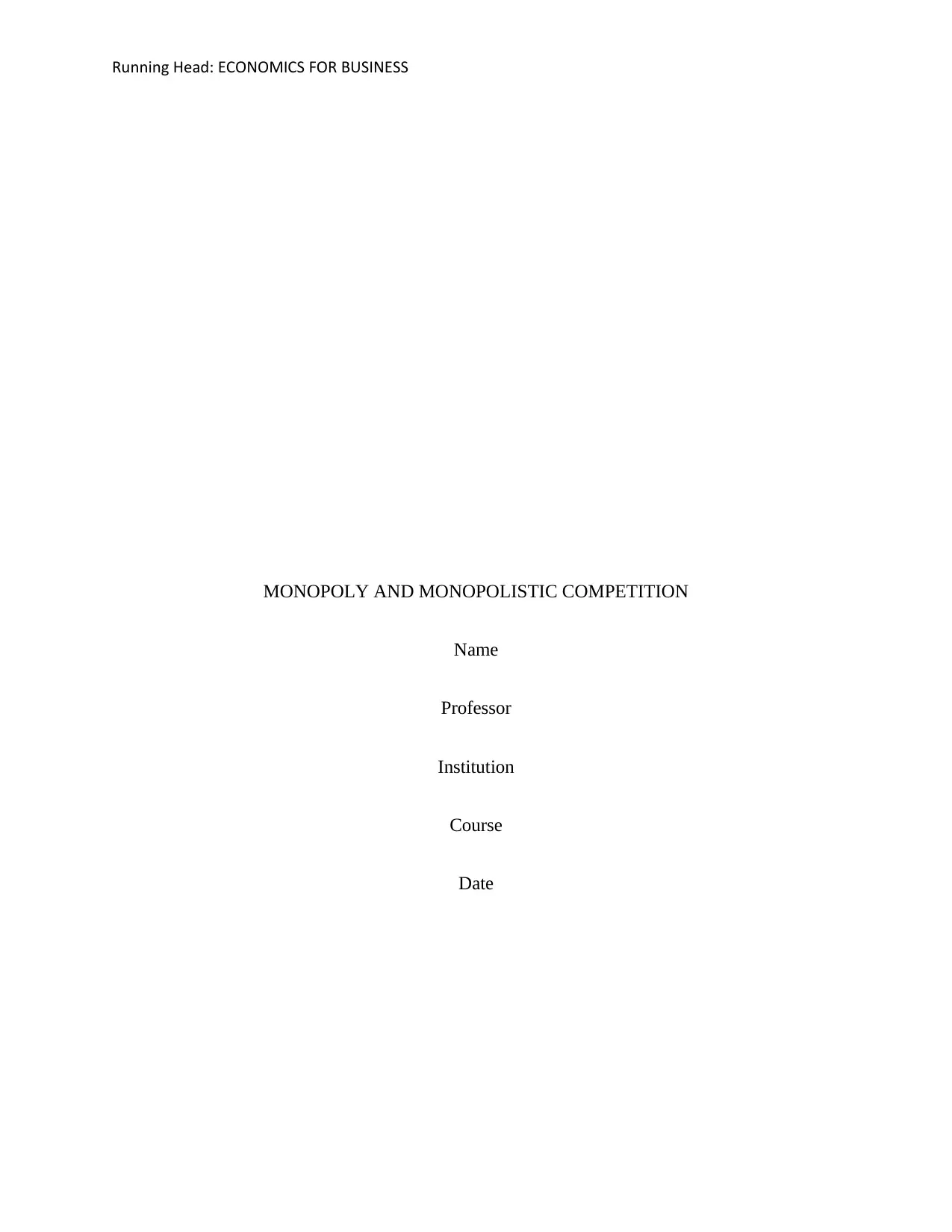
Running Head: ECONOMICS FOR BUSINESS
MONOPOLY AND MONOPOLISTIC COMPETITION
Name
Professor
Institution
Course
Date
MONOPOLY AND MONOPOLISTIC COMPETITION
Name
Professor
Institution
Course
Date
Paraphrase This Document
Need a fresh take? Get an instant paraphrase of this document with our AI Paraphraser
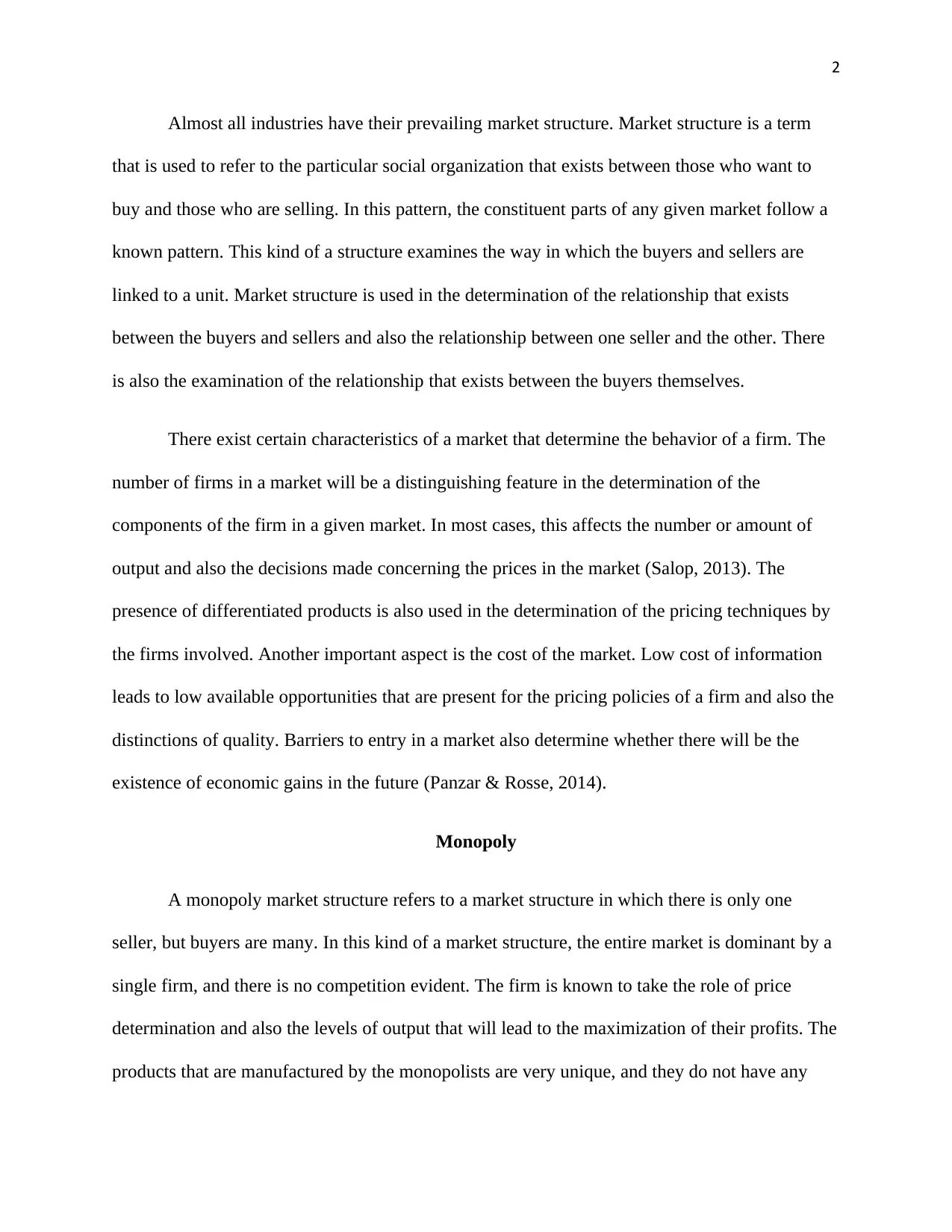
2
Almost all industries have their prevailing market structure. Market structure is a term
that is used to refer to the particular social organization that exists between those who want to
buy and those who are selling. In this pattern, the constituent parts of any given market follow a
known pattern. This kind of a structure examines the way in which the buyers and sellers are
linked to a unit. Market structure is used in the determination of the relationship that exists
between the buyers and sellers and also the relationship between one seller and the other. There
is also the examination of the relationship that exists between the buyers themselves.
There exist certain characteristics of a market that determine the behavior of a firm. The
number of firms in a market will be a distinguishing feature in the determination of the
components of the firm in a given market. In most cases, this affects the number or amount of
output and also the decisions made concerning the prices in the market (Salop, 2013). The
presence of differentiated products is also used in the determination of the pricing techniques by
the firms involved. Another important aspect is the cost of the market. Low cost of information
leads to low available opportunities that are present for the pricing policies of a firm and also the
distinctions of quality. Barriers to entry in a market also determine whether there will be the
existence of economic gains in the future (Panzar & Rosse, 2014).
Monopoly
A monopoly market structure refers to a market structure in which there is only one
seller, but buyers are many. In this kind of a market structure, the entire market is dominant by a
single firm, and there is no competition evident. The firm is known to take the role of price
determination and also the levels of output that will lead to the maximization of their profits. The
products that are manufactured by the monopolists are very unique, and they do not have any
Almost all industries have their prevailing market structure. Market structure is a term
that is used to refer to the particular social organization that exists between those who want to
buy and those who are selling. In this pattern, the constituent parts of any given market follow a
known pattern. This kind of a structure examines the way in which the buyers and sellers are
linked to a unit. Market structure is used in the determination of the relationship that exists
between the buyers and sellers and also the relationship between one seller and the other. There
is also the examination of the relationship that exists between the buyers themselves.
There exist certain characteristics of a market that determine the behavior of a firm. The
number of firms in a market will be a distinguishing feature in the determination of the
components of the firm in a given market. In most cases, this affects the number or amount of
output and also the decisions made concerning the prices in the market (Salop, 2013). The
presence of differentiated products is also used in the determination of the pricing techniques by
the firms involved. Another important aspect is the cost of the market. Low cost of information
leads to low available opportunities that are present for the pricing policies of a firm and also the
distinctions of quality. Barriers to entry in a market also determine whether there will be the
existence of economic gains in the future (Panzar & Rosse, 2014).
Monopoly
A monopoly market structure refers to a market structure in which there is only one
seller, but buyers are many. In this kind of a market structure, the entire market is dominant by a
single firm, and there is no competition evident. The firm is known to take the role of price
determination and also the levels of output that will lead to the maximization of their profits. The
products that are manufactured by the monopolists are very unique, and they do not have any
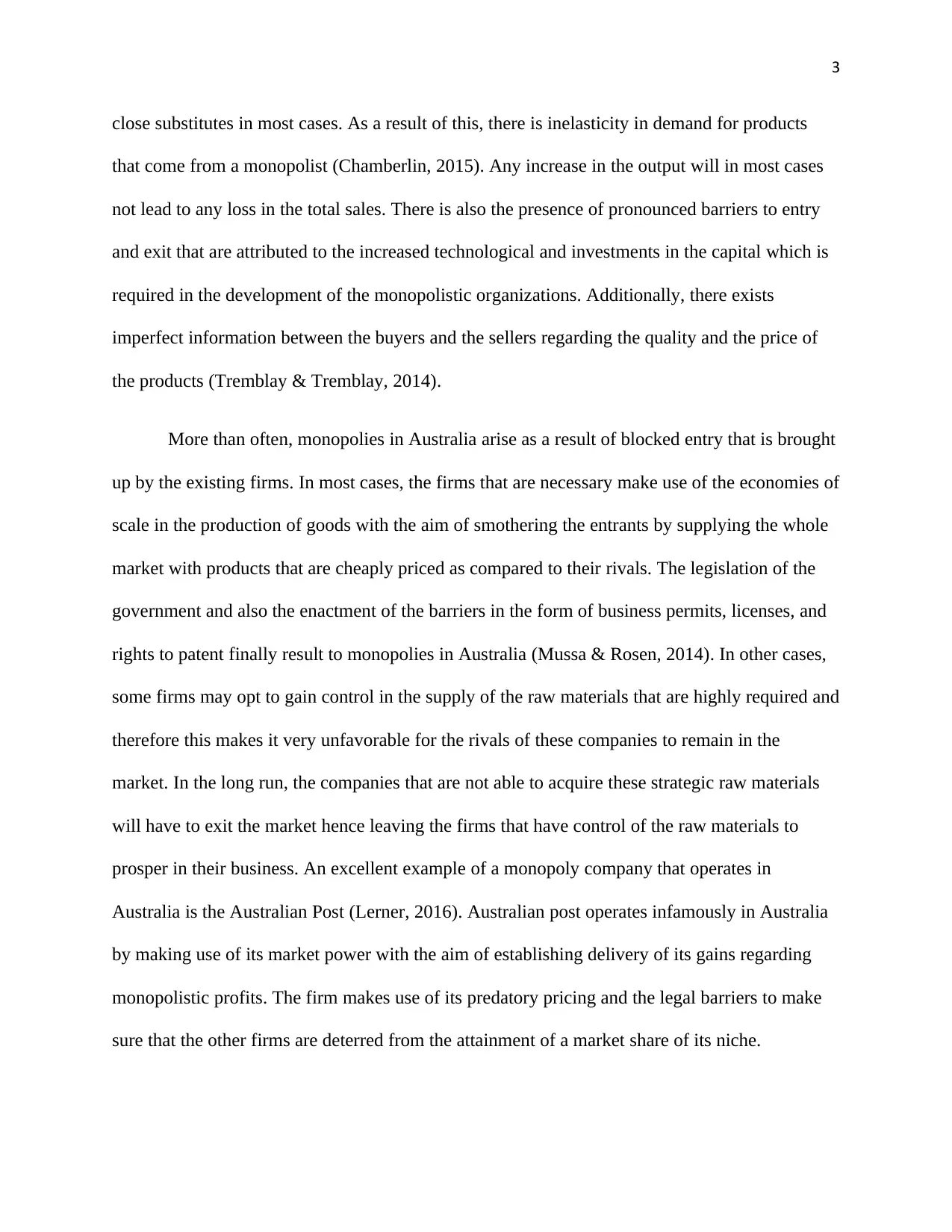
3
close substitutes in most cases. As a result of this, there is inelasticity in demand for products
that come from a monopolist (Chamberlin, 2015). Any increase in the output will in most cases
not lead to any loss in the total sales. There is also the presence of pronounced barriers to entry
and exit that are attributed to the increased technological and investments in the capital which is
required in the development of the monopolistic organizations. Additionally, there exists
imperfect information between the buyers and the sellers regarding the quality and the price of
the products (Tremblay & Tremblay, 2014).
More than often, monopolies in Australia arise as a result of blocked entry that is brought
up by the existing firms. In most cases, the firms that are necessary make use of the economies of
scale in the production of goods with the aim of smothering the entrants by supplying the whole
market with products that are cheaply priced as compared to their rivals. The legislation of the
government and also the enactment of the barriers in the form of business permits, licenses, and
rights to patent finally result to monopolies in Australia (Mussa & Rosen, 2014). In other cases,
some firms may opt to gain control in the supply of the raw materials that are highly required and
therefore this makes it very unfavorable for the rivals of these companies to remain in the
market. In the long run, the companies that are not able to acquire these strategic raw materials
will have to exit the market hence leaving the firms that have control of the raw materials to
prosper in their business. An excellent example of a monopoly company that operates in
Australia is the Australian Post (Lerner, 2016). Australian post operates infamously in Australia
by making use of its market power with the aim of establishing delivery of its gains regarding
monopolistic profits. The firm makes use of its predatory pricing and the legal barriers to make
sure that the other firms are deterred from the attainment of a market share of its niche.
close substitutes in most cases. As a result of this, there is inelasticity in demand for products
that come from a monopolist (Chamberlin, 2015). Any increase in the output will in most cases
not lead to any loss in the total sales. There is also the presence of pronounced barriers to entry
and exit that are attributed to the increased technological and investments in the capital which is
required in the development of the monopolistic organizations. Additionally, there exists
imperfect information between the buyers and the sellers regarding the quality and the price of
the products (Tremblay & Tremblay, 2014).
More than often, monopolies in Australia arise as a result of blocked entry that is brought
up by the existing firms. In most cases, the firms that are necessary make use of the economies of
scale in the production of goods with the aim of smothering the entrants by supplying the whole
market with products that are cheaply priced as compared to their rivals. The legislation of the
government and also the enactment of the barriers in the form of business permits, licenses, and
rights to patent finally result to monopolies in Australia (Mussa & Rosen, 2014). In other cases,
some firms may opt to gain control in the supply of the raw materials that are highly required and
therefore this makes it very unfavorable for the rivals of these companies to remain in the
market. In the long run, the companies that are not able to acquire these strategic raw materials
will have to exit the market hence leaving the firms that have control of the raw materials to
prosper in their business. An excellent example of a monopoly company that operates in
Australia is the Australian Post (Lerner, 2016). Australian post operates infamously in Australia
by making use of its market power with the aim of establishing delivery of its gains regarding
monopolistic profits. The firm makes use of its predatory pricing and the legal barriers to make
sure that the other firms are deterred from the attainment of a market share of its niche.
⊘ This is a preview!⊘
Do you want full access?
Subscribe today to unlock all pages.

Trusted by 1+ million students worldwide
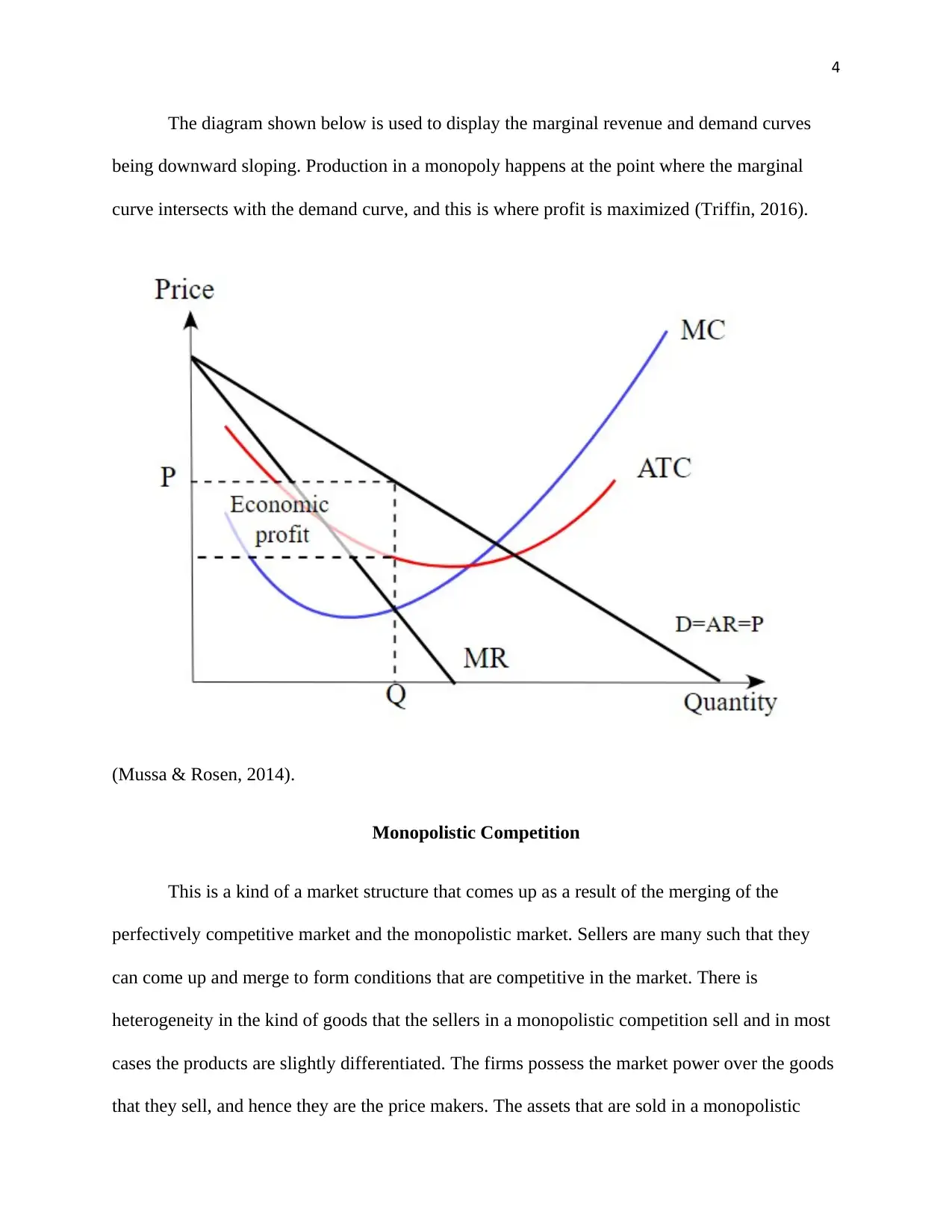
4
The diagram shown below is used to display the marginal revenue and demand curves
being downward sloping. Production in a monopoly happens at the point where the marginal
curve intersects with the demand curve, and this is where profit is maximized (Triffin, 2016).
(Mussa & Rosen, 2014).
Monopolistic Competition
This is a kind of a market structure that comes up as a result of the merging of the
perfectively competitive market and the monopolistic market. Sellers are many such that they
can come up and merge to form conditions that are competitive in the market. There is
heterogeneity in the kind of goods that the sellers in a monopolistic competition sell and in most
cases the products are slightly differentiated. The firms possess the market power over the goods
that they sell, and hence they are the price makers. The assets that are sold in a monopolistic
The diagram shown below is used to display the marginal revenue and demand curves
being downward sloping. Production in a monopoly happens at the point where the marginal
curve intersects with the demand curve, and this is where profit is maximized (Triffin, 2016).
(Mussa & Rosen, 2014).
Monopolistic Competition
This is a kind of a market structure that comes up as a result of the merging of the
perfectively competitive market and the monopolistic market. Sellers are many such that they
can come up and merge to form conditions that are competitive in the market. There is
heterogeneity in the kind of goods that the sellers in a monopolistic competition sell and in most
cases the products are slightly differentiated. The firms possess the market power over the goods
that they sell, and hence they are the price makers. The assets that are sold in a monopolistic
Paraphrase This Document
Need a fresh take? Get an instant paraphrase of this document with our AI Paraphraser
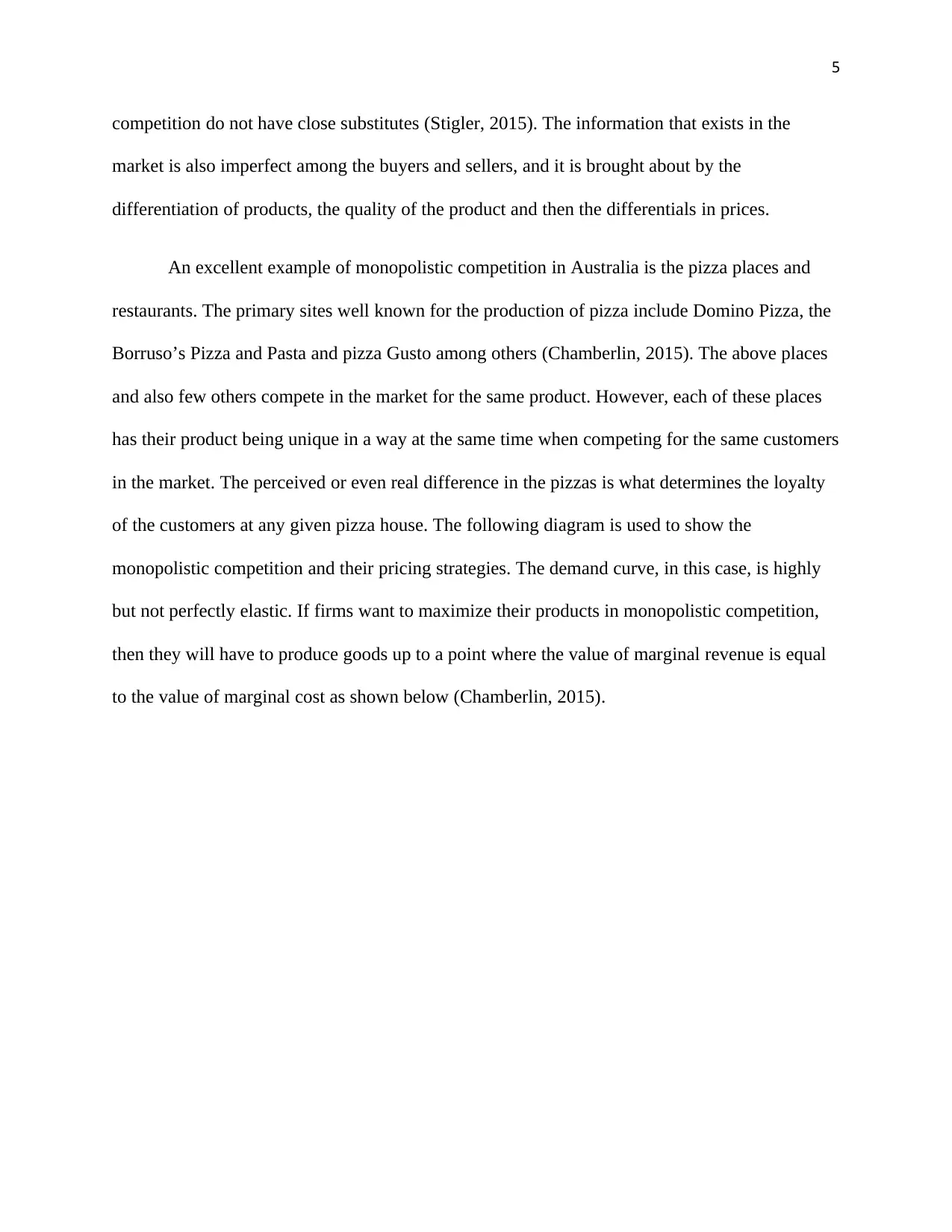
5
competition do not have close substitutes (Stigler, 2015). The information that exists in the
market is also imperfect among the buyers and sellers, and it is brought about by the
differentiation of products, the quality of the product and then the differentials in prices.
An excellent example of monopolistic competition in Australia is the pizza places and
restaurants. The primary sites well known for the production of pizza include Domino Pizza, the
Borruso’s Pizza and Pasta and pizza Gusto among others (Chamberlin, 2015). The above places
and also few others compete in the market for the same product. However, each of these places
has their product being unique in a way at the same time when competing for the same customers
in the market. The perceived or even real difference in the pizzas is what determines the loyalty
of the customers at any given pizza house. The following diagram is used to show the
monopolistic competition and their pricing strategies. The demand curve, in this case, is highly
but not perfectly elastic. If firms want to maximize their products in monopolistic competition,
then they will have to produce goods up to a point where the value of marginal revenue is equal
to the value of marginal cost as shown below (Chamberlin, 2015).
competition do not have close substitutes (Stigler, 2015). The information that exists in the
market is also imperfect among the buyers and sellers, and it is brought about by the
differentiation of products, the quality of the product and then the differentials in prices.
An excellent example of monopolistic competition in Australia is the pizza places and
restaurants. The primary sites well known for the production of pizza include Domino Pizza, the
Borruso’s Pizza and Pasta and pizza Gusto among others (Chamberlin, 2015). The above places
and also few others compete in the market for the same product. However, each of these places
has their product being unique in a way at the same time when competing for the same customers
in the market. The perceived or even real difference in the pizzas is what determines the loyalty
of the customers at any given pizza house. The following diagram is used to show the
monopolistic competition and their pricing strategies. The demand curve, in this case, is highly
but not perfectly elastic. If firms want to maximize their products in monopolistic competition,
then they will have to produce goods up to a point where the value of marginal revenue is equal
to the value of marginal cost as shown below (Chamberlin, 2015).
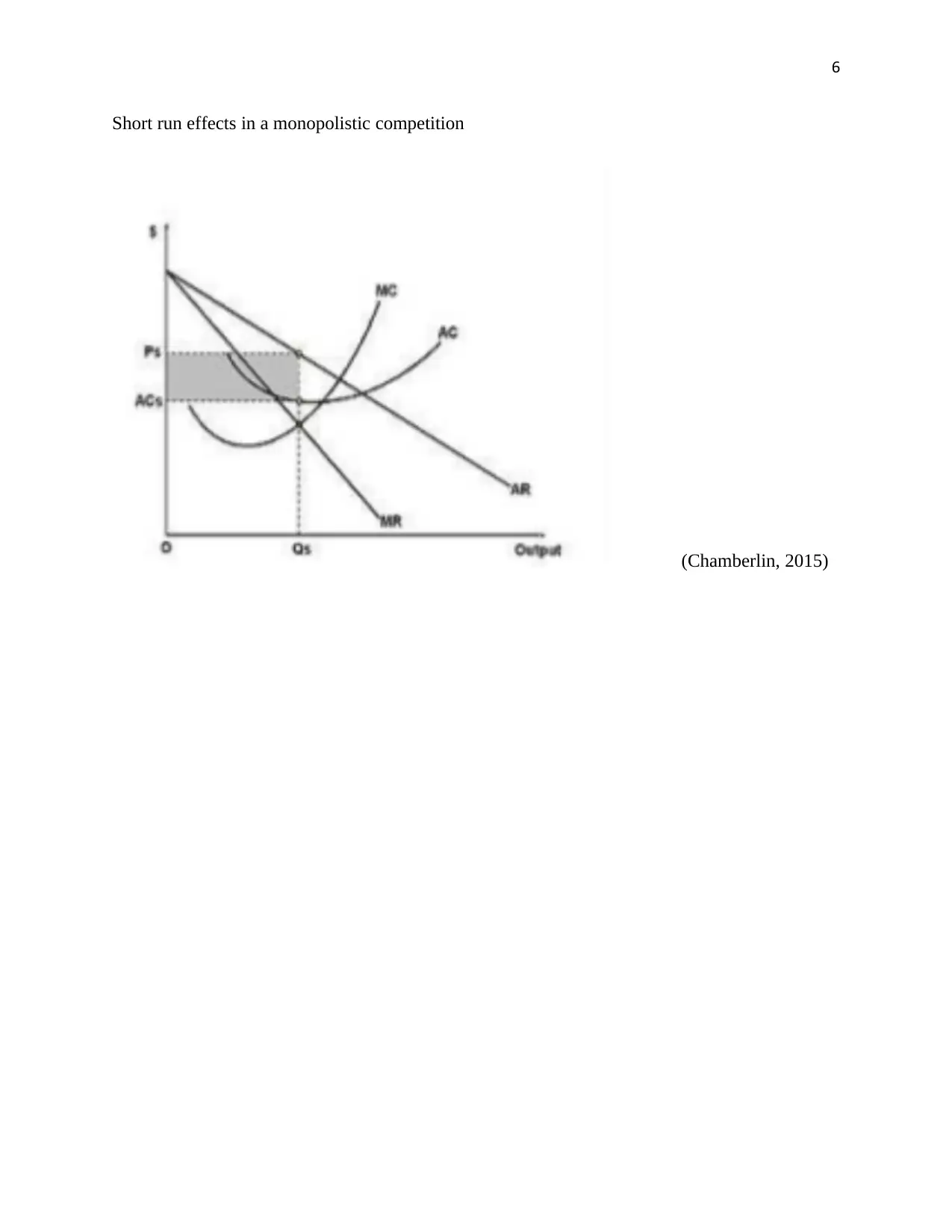
6
Short run effects in a monopolistic competition
(Chamberlin, 2015)
Short run effects in a monopolistic competition
(Chamberlin, 2015)
⊘ This is a preview!⊘
Do you want full access?
Subscribe today to unlock all pages.

Trusted by 1+ million students worldwide
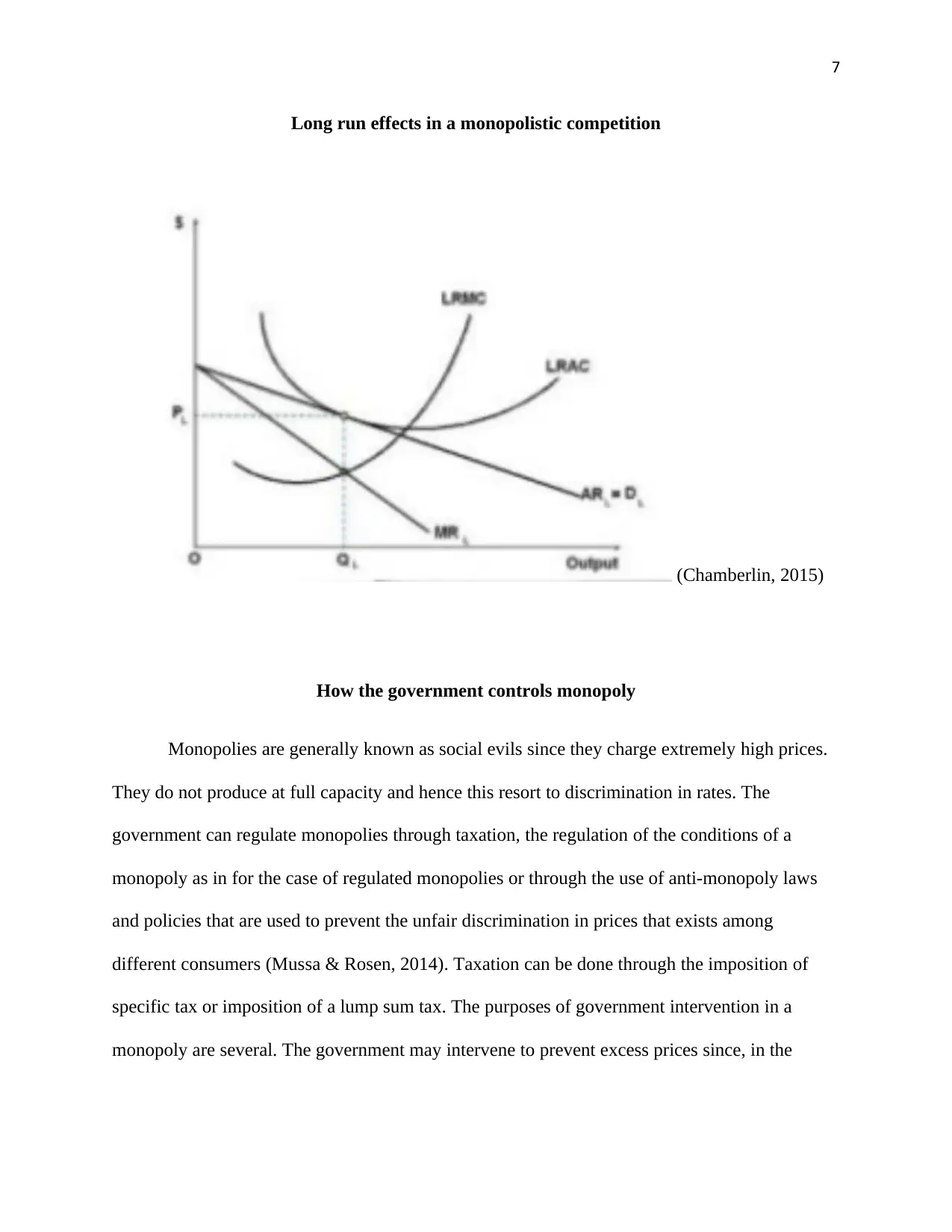
7
Long run effects in a monopolistic competition
(Chamberlin, 2015)
How the government controls monopoly
Monopolies are generally known as social evils since they charge extremely high prices.
They do not produce at full capacity and hence this resort to discrimination in rates. The
government can regulate monopolies through taxation, the regulation of the conditions of a
monopoly as in for the case of regulated monopolies or through the use of anti-monopoly laws
and policies that are used to prevent the unfair discrimination in prices that exists among
different consumers (Mussa & Rosen, 2014). Taxation can be done through the imposition of
specific tax or imposition of a lump sum tax. The purposes of government intervention in a
monopoly are several. The government may intervene to prevent excess prices since, in the
Long run effects in a monopolistic competition
(Chamberlin, 2015)
How the government controls monopoly
Monopolies are generally known as social evils since they charge extremely high prices.
They do not produce at full capacity and hence this resort to discrimination in rates. The
government can regulate monopolies through taxation, the regulation of the conditions of a
monopoly as in for the case of regulated monopolies or through the use of anti-monopoly laws
and policies that are used to prevent the unfair discrimination in prices that exists among
different consumers (Mussa & Rosen, 2014). Taxation can be done through the imposition of
specific tax or imposition of a lump sum tax. The purposes of government intervention in a
monopoly are several. The government may intervene to prevent excess prices since, in the
Paraphrase This Document
Need a fresh take? Get an instant paraphrase of this document with our AI Paraphraser
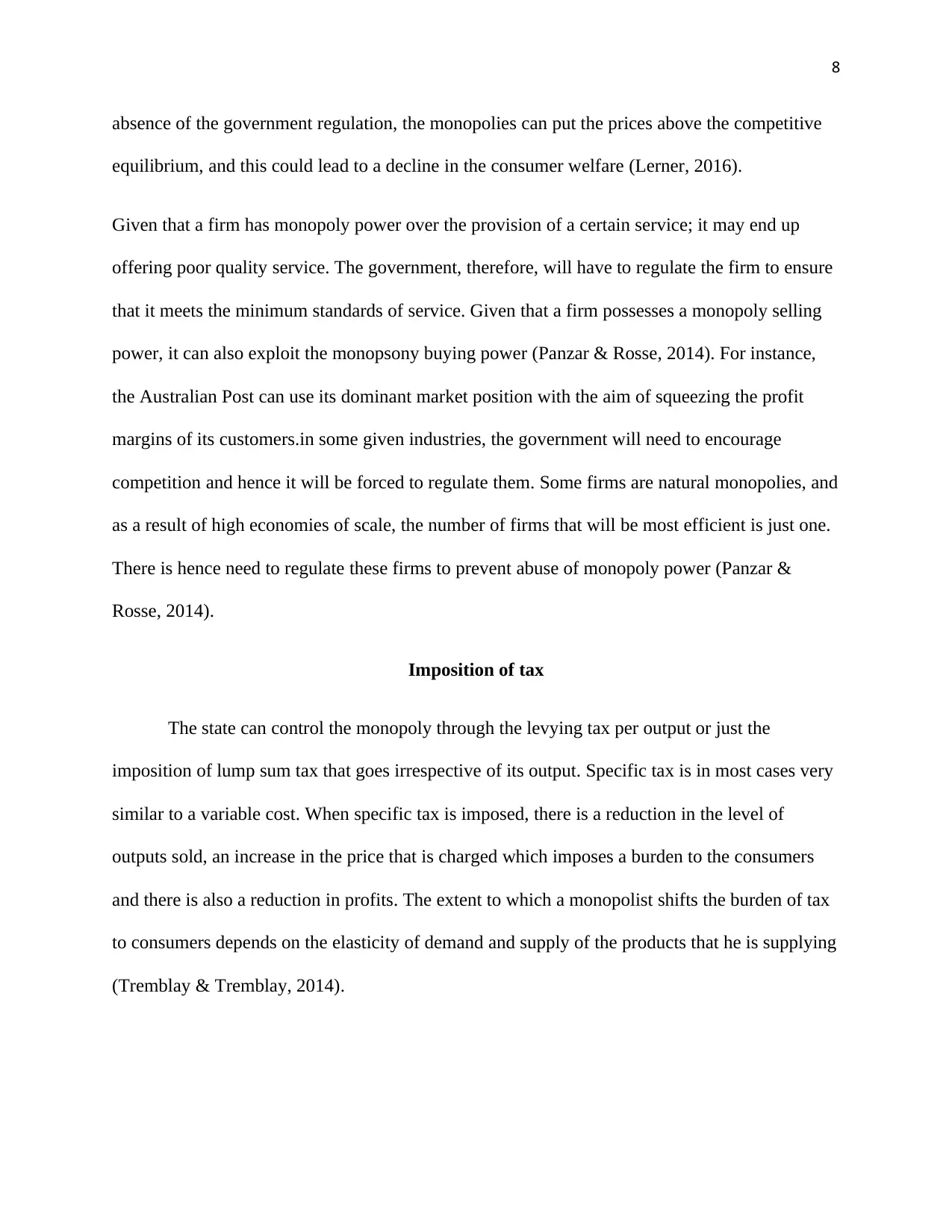
8
absence of the government regulation, the monopolies can put the prices above the competitive
equilibrium, and this could lead to a decline in the consumer welfare (Lerner, 2016).
Given that a firm has monopoly power over the provision of a certain service; it may end up
offering poor quality service. The government, therefore, will have to regulate the firm to ensure
that it meets the minimum standards of service. Given that a firm possesses a monopoly selling
power, it can also exploit the monopsony buying power (Panzar & Rosse, 2014). For instance,
the Australian Post can use its dominant market position with the aim of squeezing the profit
margins of its customers.in some given industries, the government will need to encourage
competition and hence it will be forced to regulate them. Some firms are natural monopolies, and
as a result of high economies of scale, the number of firms that will be most efficient is just one.
There is hence need to regulate these firms to prevent abuse of monopoly power (Panzar &
Rosse, 2014).
Imposition of tax
The state can control the monopoly through the levying tax per output or just the
imposition of lump sum tax that goes irrespective of its output. Specific tax is in most cases very
similar to a variable cost. When specific tax is imposed, there is a reduction in the level of
outputs sold, an increase in the price that is charged which imposes a burden to the consumers
and there is also a reduction in profits. The extent to which a monopolist shifts the burden of tax
to consumers depends on the elasticity of demand and supply of the products that he is supplying
(Tremblay & Tremblay, 2014).
absence of the government regulation, the monopolies can put the prices above the competitive
equilibrium, and this could lead to a decline in the consumer welfare (Lerner, 2016).
Given that a firm has monopoly power over the provision of a certain service; it may end up
offering poor quality service. The government, therefore, will have to regulate the firm to ensure
that it meets the minimum standards of service. Given that a firm possesses a monopoly selling
power, it can also exploit the monopsony buying power (Panzar & Rosse, 2014). For instance,
the Australian Post can use its dominant market position with the aim of squeezing the profit
margins of its customers.in some given industries, the government will need to encourage
competition and hence it will be forced to regulate them. Some firms are natural monopolies, and
as a result of high economies of scale, the number of firms that will be most efficient is just one.
There is hence need to regulate these firms to prevent abuse of monopoly power (Panzar &
Rosse, 2014).
Imposition of tax
The state can control the monopoly through the levying tax per output or just the
imposition of lump sum tax that goes irrespective of its output. Specific tax is in most cases very
similar to a variable cost. When specific tax is imposed, there is a reduction in the level of
outputs sold, an increase in the price that is charged which imposes a burden to the consumers
and there is also a reduction in profits. The extent to which a monopolist shifts the burden of tax
to consumers depends on the elasticity of demand and supply of the products that he is supplying
(Tremblay & Tremblay, 2014).
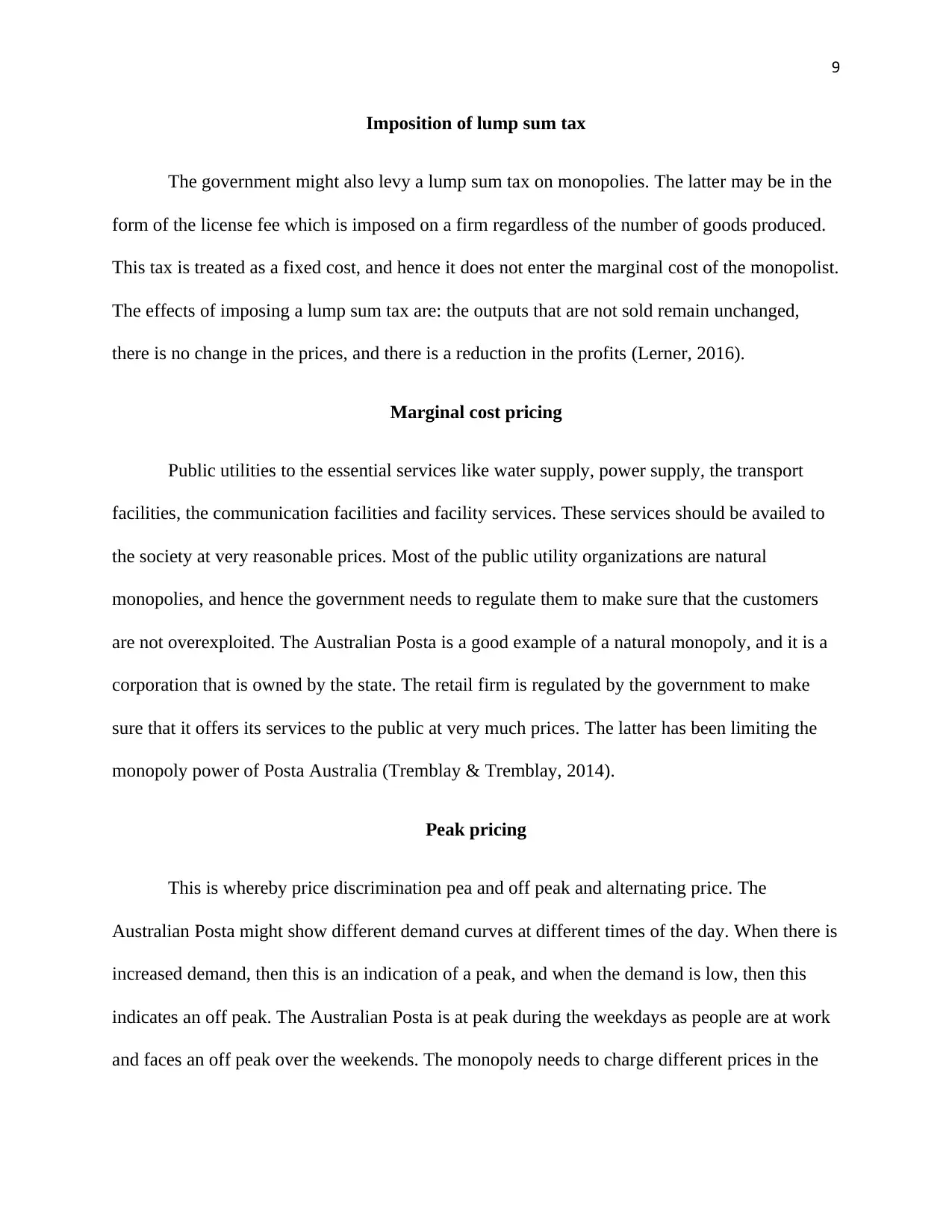
9
Imposition of lump sum tax
The government might also levy a lump sum tax on monopolies. The latter may be in the
form of the license fee which is imposed on a firm regardless of the number of goods produced.
This tax is treated as a fixed cost, and hence it does not enter the marginal cost of the monopolist.
The effects of imposing a lump sum tax are: the outputs that are not sold remain unchanged,
there is no change in the prices, and there is a reduction in the profits (Lerner, 2016).
Marginal cost pricing
Public utilities to the essential services like water supply, power supply, the transport
facilities, the communication facilities and facility services. These services should be availed to
the society at very reasonable prices. Most of the public utility organizations are natural
monopolies, and hence the government needs to regulate them to make sure that the customers
are not overexploited. The Australian Posta is a good example of a natural monopoly, and it is a
corporation that is owned by the state. The retail firm is regulated by the government to make
sure that it offers its services to the public at very much prices. The latter has been limiting the
monopoly power of Posta Australia (Tremblay & Tremblay, 2014).
Peak pricing
This is whereby price discrimination pea and off peak and alternating price. The
Australian Posta might show different demand curves at different times of the day. When there is
increased demand, then this is an indication of a peak, and when the demand is low, then this
indicates an off peak. The Australian Posta is at peak during the weekdays as people are at work
and faces an off peak over the weekends. The monopoly needs to charge different prices in the
Imposition of lump sum tax
The government might also levy a lump sum tax on monopolies. The latter may be in the
form of the license fee which is imposed on a firm regardless of the number of goods produced.
This tax is treated as a fixed cost, and hence it does not enter the marginal cost of the monopolist.
The effects of imposing a lump sum tax are: the outputs that are not sold remain unchanged,
there is no change in the prices, and there is a reduction in the profits (Lerner, 2016).
Marginal cost pricing
Public utilities to the essential services like water supply, power supply, the transport
facilities, the communication facilities and facility services. These services should be availed to
the society at very reasonable prices. Most of the public utility organizations are natural
monopolies, and hence the government needs to regulate them to make sure that the customers
are not overexploited. The Australian Posta is a good example of a natural monopoly, and it is a
corporation that is owned by the state. The retail firm is regulated by the government to make
sure that it offers its services to the public at very much prices. The latter has been limiting the
monopoly power of Posta Australia (Tremblay & Tremblay, 2014).
Peak pricing
This is whereby price discrimination pea and off peak and alternating price. The
Australian Posta might show different demand curves at different times of the day. When there is
increased demand, then this is an indication of a peak, and when the demand is low, then this
indicates an off peak. The Australian Posta is at peak during the weekdays as people are at work
and faces an off peak over the weekends. The monopoly needs to charge different prices in the
⊘ This is a preview!⊘
Do you want full access?
Subscribe today to unlock all pages.

Trusted by 1+ million students worldwide
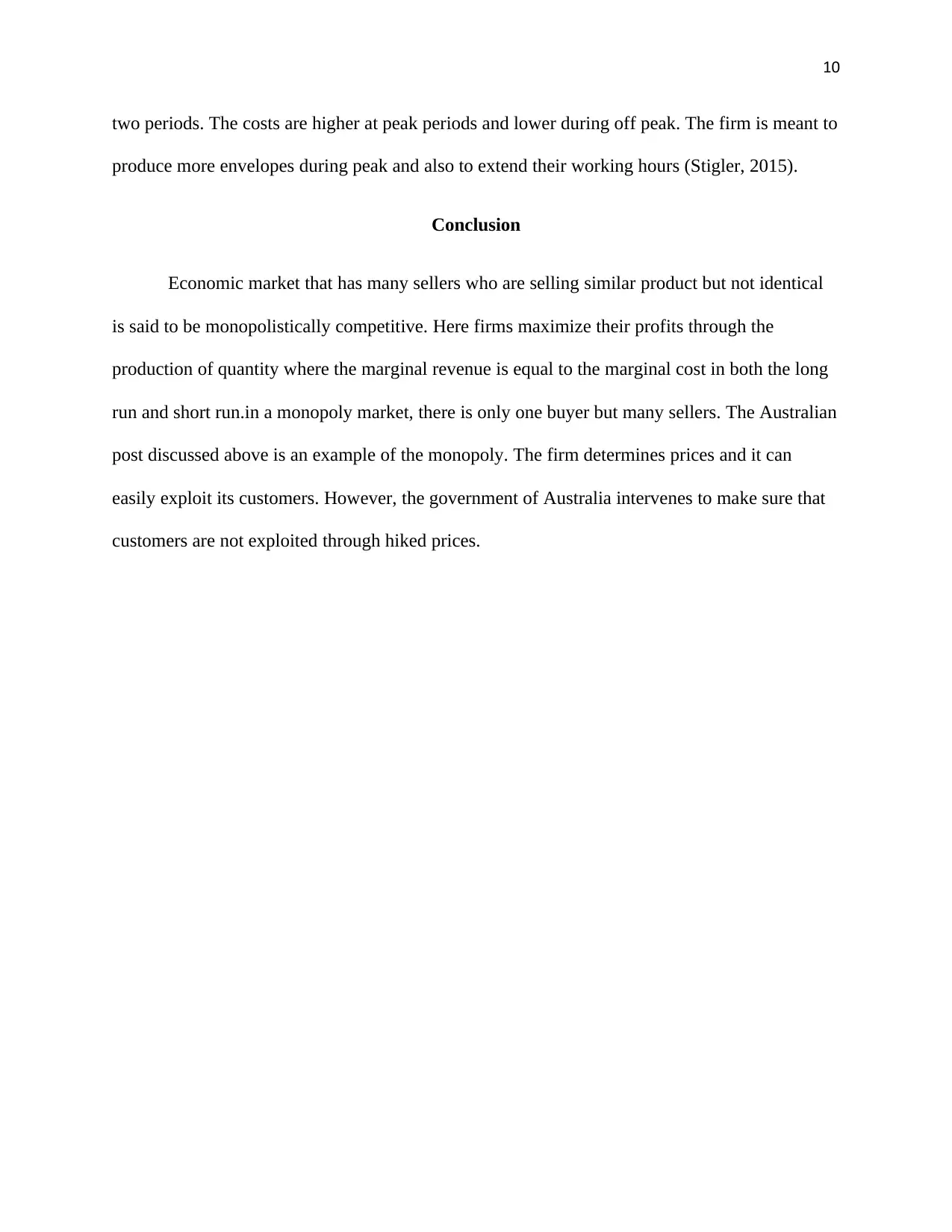
10
two periods. The costs are higher at peak periods and lower during off peak. The firm is meant to
produce more envelopes during peak and also to extend their working hours (Stigler, 2015).
Conclusion
Economic market that has many sellers who are selling similar product but not identical
is said to be monopolistically competitive. Here firms maximize their profits through the
production of quantity where the marginal revenue is equal to the marginal cost in both the long
run and short run.in a monopoly market, there is only one buyer but many sellers. The Australian
post discussed above is an example of the monopoly. The firm determines prices and it can
easily exploit its customers. However, the government of Australia intervenes to make sure that
customers are not exploited through hiked prices.
two periods. The costs are higher at peak periods and lower during off peak. The firm is meant to
produce more envelopes during peak and also to extend their working hours (Stigler, 2015).
Conclusion
Economic market that has many sellers who are selling similar product but not identical
is said to be monopolistically competitive. Here firms maximize their profits through the
production of quantity where the marginal revenue is equal to the marginal cost in both the long
run and short run.in a monopoly market, there is only one buyer but many sellers. The Australian
post discussed above is an example of the monopoly. The firm determines prices and it can
easily exploit its customers. However, the government of Australia intervenes to make sure that
customers are not exploited through hiked prices.
Paraphrase This Document
Need a fresh take? Get an instant paraphrase of this document with our AI Paraphraser
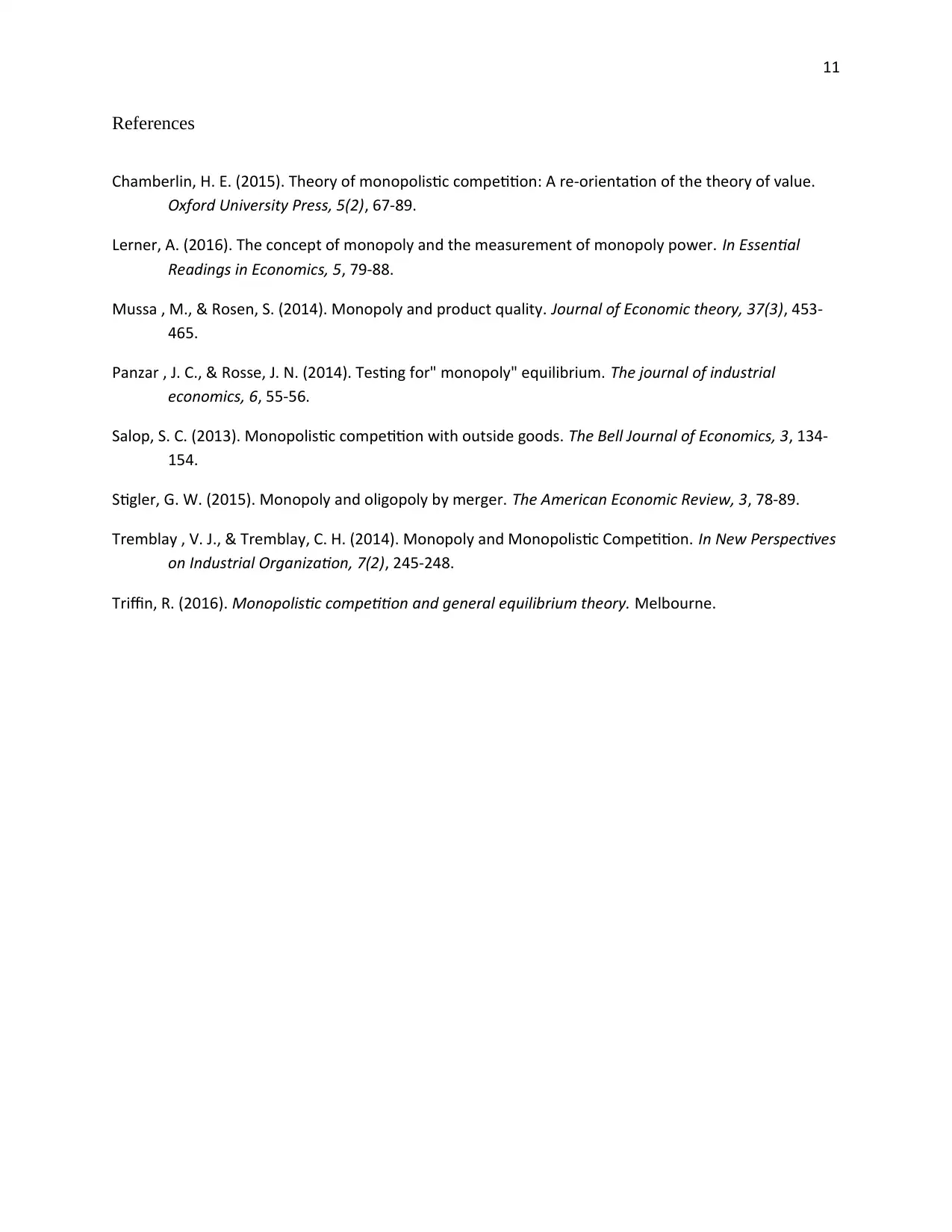
11
References
Chamberlin, H. E. (2015). Theory of monopolistic competition: A re-orientation of the theory of value.
Oxford University Press, 5(2), 67-89.
Lerner, A. (2016). The concept of monopoly and the measurement of monopoly power. In Essential
Readings in Economics, 5, 79-88.
Mussa , M., & Rosen, S. (2014). Monopoly and product quality. Journal of Economic theory, 37(3), 453-
465.
Panzar , J. C., & Rosse, J. N. (2014). Testing for" monopoly" equilibrium. The journal of industrial
economics, 6, 55-56.
Salop, S. C. (2013). Monopolistic competition with outside goods. The Bell Journal of Economics, 3, 134-
154.
Stigler, G. W. (2015). Monopoly and oligopoly by merger. The American Economic Review, 3, 78-89.
Tremblay , V. J., & Tremblay, C. H. (2014). Monopoly and Monopolistic Competition. In New Perspectives
on Industrial Organization, 7(2), 245-248.
Triffin, R. (2016). Monopolistic competition and general equilibrium theory. Melbourne.
References
Chamberlin, H. E. (2015). Theory of monopolistic competition: A re-orientation of the theory of value.
Oxford University Press, 5(2), 67-89.
Lerner, A. (2016). The concept of monopoly and the measurement of monopoly power. In Essential
Readings in Economics, 5, 79-88.
Mussa , M., & Rosen, S. (2014). Monopoly and product quality. Journal of Economic theory, 37(3), 453-
465.
Panzar , J. C., & Rosse, J. N. (2014). Testing for" monopoly" equilibrium. The journal of industrial
economics, 6, 55-56.
Salop, S. C. (2013). Monopolistic competition with outside goods. The Bell Journal of Economics, 3, 134-
154.
Stigler, G. W. (2015). Monopoly and oligopoly by merger. The American Economic Review, 3, 78-89.
Tremblay , V. J., & Tremblay, C. H. (2014). Monopoly and Monopolistic Competition. In New Perspectives
on Industrial Organization, 7(2), 245-248.
Triffin, R. (2016). Monopolistic competition and general equilibrium theory. Melbourne.
1 out of 11
Related Documents
Your All-in-One AI-Powered Toolkit for Academic Success.
+13062052269
info@desklib.com
Available 24*7 on WhatsApp / Email
![[object Object]](/_next/static/media/star-bottom.7253800d.svg)
Unlock your academic potential
Copyright © 2020–2025 A2Z Services. All Rights Reserved. Developed and managed by ZUCOL.





